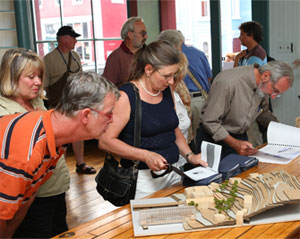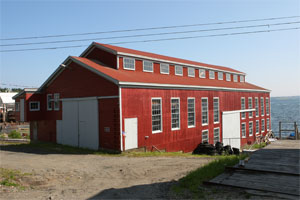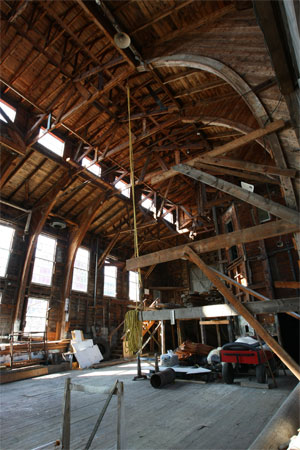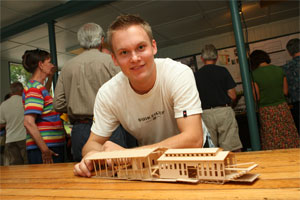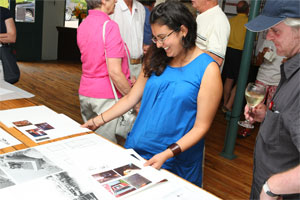| ||
| ||
| ||
| ||
|
The glory days of shipbuilding and the salt-fish trade were gone, but Nova Scotia’s seafaring tradition would live on in the Bluenose II, a new schooner built to architect W.J. Roué’s original plans.
But now, 40-odd years later, the shed is launching something else‚ÄĒsome fresh ideas to revive the Lunenburg waterfront.
Since Clearwater Foods announced plans to abandon operations in the historic seaside town in 2003, dozens of buildings in prime spots on the waterfront have been vacated. The spacious Bluenose shed, for example, is used for storage.
Control of the site was secured by the Lunenburg Waterfront Association in 2005. The community-based development agency has been trying to figure out what to do with the buildings, which number more than 20 and include storefronts, the ice plant, machine shop, warehouses, offices and sheds.
Steven Mannell, professor of architecture at AVĺ„ņ÷≤Ņ, decided to put the quandary to master‚Äôs students in his class, Adaptive Reuse Studio (ARCH 5003): What could these buildings be reused for, while remaining within the context of a working waterfront? In other words, he wasn‚Äôt interested in cool loft apartments or condominiums with ocean views. New uses for buildings would have to be in keeping with Lunenburg‚Äôs ‚Äúliving tradition of industrial craft and ingenuity.‚ÄĚ
On Wednesday night, in a former gear shop on Montague Street, the students presented those ideas to residents of Lunenburg. The Bluenose shed, for example, was re-envisioned alternately as a community theatre, a nondenominational chapel, an interpretative centre and a solar aquatics sewage treatment plant; the ice house would make a neat youth hostel; and the old forge could be a music centre, housing a performance hall, rehearsal studios and recording studio. 
‚ÄúThese buildings represent a significant opportunity‚ÄĒthere‚Äôs a vast amount of space just sitting and waiting for the right thing to happen,‚ÄĚ said Prof. Mannell at Tuesday‚Äôs opening reception. AVĺ„ņ÷≤Ņ 50 townsfolk showed up to see what the students came up with, sip wine and nibble hors d‚Äôoeuvres. ‚ÄúBut then, the waterfront is a story of adaptation, ingenuity and figuring out what to do when things change.‚ÄĚ
Jordan Molnar, for one, took a look at the Bluenose shed and saw a theatre in its soaring timber build structure. From Brampton, Ont., he imagined it with a glass floor to expose the original cribbing and the water beneath, and extending it out further into the harbour, where people in small boats could join in as part of the audience. Behsheed Darvish from Vancouver was also drawn to the shed, envisioning it as a place where craftspeople, like surfboard makers, boat builders and heritage carpenters could ply their trades, while ‚Äúputting the building itself on display.‚ÄĚ
‚ÄúI think it would be neat to extend the building further into the harbour, with platforms where people can gather ‚Ķ and then when they moved inside, they would discover this absolute gem.‚ÄĚ
Colin Carrigan, from St. John‚Äôs, Nfld., proposed a music centre for the old forge, drawn by its large size, tall rafters, and wood construction. ‚ÄúYou go in there and it‚Äôs as if you‚Äôve entered a church. It seemed like a sexy space for this kind of project.‚ÄĚ
But like the Christmas present the recipient calls ‚Äúinteresting,‚ÄĚ members of the community said they appreciated the students‚Äô efforts but didn‚Äôt think their ideas were suitable for their town, described as somewhat conservative in nature. Looking over the plans to transform the old ice house into a youth hostel, Rosie and Mike Severs said the students could have come up with more viable suggestions had they consulted with townsfolk beforehand. ‚ÄúI wish there was more of an effort to blend with the environment we live in,‚ÄĚ said Rosie.
But Gerry Rolfsen, a retired architect who has lived in Lunenburg for the past eight years, says while there may be a disconnection between what was presented‚ÄĒ‚ÄúI mean how many performing arts facilities do we need?‚ÄĚ‚ÄĒ and what local people want, that wasn‚Äôt really the point of the exercise. As he witnessed last year, the exhibition acted as a catalyst to get discussion going‚ÄĒ‚Äúfrom neighbor to neighbor.‚ÄĚ
‚ÄúIt‚Äôs true, we don‚Äôt like people from the outside coming in and telling us what to do,‚ÄĚ says Mr. Rolfsen, a member of the Lunenburg Waterfront Association. ‚ÄúBut, anything that‚Äôs stimulating and gets people arguing and talking is good for the town.‚ÄĚ
Visions for the Lunenburg Waterfront, an exhibition of student work, is on display at 182 Montague Street, Lunenburg, Thursday, July 31, 10 a.m. to 7 p.m., and Friday, Aug. 1, 10 a.m. to 1 p.m.
READ: in The Chronicle-Herald

